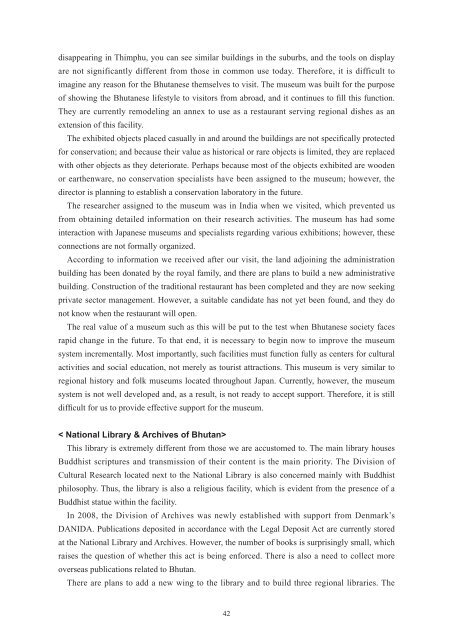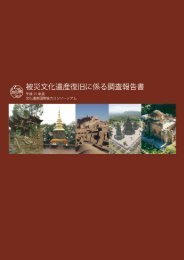English - JCIC-Heritage
English - JCIC-Heritage
English - JCIC-Heritage
You also want an ePaper? Increase the reach of your titles
YUMPU automatically turns print PDFs into web optimized ePapers that Google loves.
disappearing in Thimphu, you can see similar buildings in the suburbs, and the tools on display<br />
are not significantly different from those in common use today. Therefore, it is difficult to<br />
imagine any reason for the Bhutanese themselves to visit. The museum was built for the purpose<br />
of showing the Bhutanese lifestyle to visitors from abroad, and it continues to fill this function.<br />
They are currently remodeling an annex to use as a restaurant serving regional dishes as an<br />
extension of this facility.<br />
The exhibited objects placed casually in and around the buildings are not specifically protected<br />
for conservation; and because their value as historical or rare objects is limited, they are replaced<br />
with other objects as they deteriorate. Perhaps because most of the objects exhibited are wooden<br />
or earthenware, no conservation specialists have been assigned to the museum; however, the<br />
director is planning to establish a conservation laboratory in the future.<br />
The researcher assigned to the museum was in India when we visited, which prevented us<br />
from obtaining detailed information on their research activities. The museum has had some<br />
interaction with Japanese museums and specialists regarding various exhibitions; however, these<br />
connections are not formally organized.<br />
According to information we received after our visit, the land adjoining the administration<br />
building has been donated by the royal family, and there are plans to build a new administrative<br />
building. Construction of the traditional restaurant has been completed and they are now seeking<br />
private sector management. However, a suitable candidate has not yet been found, and they do<br />
not know when the restaurant will open.<br />
The real value of a museum such as this will be put to the test when Bhutanese society faces<br />
rapid change in the future. To that end, it is necessary to begin now to improve the museum<br />
system incrementally. Most importantly, such facilities must function fully as centers for cultural<br />
activities and social education, not merely as tourist attractions. This museum is very similar to<br />
regional history and folk museums located throughout Japan. Currently, however, the museum<br />
system is not well developed and, as a result, is not ready to accept support. Therefore, it is still<br />
difficult for us to provide effective support for the museum.<br />
< National Library & Archives of Bhutan><br />
This library is extremely different from those we are accustomed to. The main library houses<br />
Buddhist scriptures and transmission of their content is the main priority. The Division of<br />
Cultural Research located next to the National Library is also concerned mainly with Buddhist<br />
philosophy. Thus, the library is also a religious facility, which is evident from the presence of a<br />
Buddhist statue within the facility.<br />
In 2008, the Division of Archives was newly established with support from Denmark’s<br />
DANIDA. Publications deposited in accordance with the Legal Deposit Act are currently stored<br />
at the National Library and Archives. However, the number of books is surprisingly small, which<br />
raises the question of whether this act is being enforced. There is also a need to collect more<br />
overseas publications related to Bhutan.<br />
There are plans to add a new wing to the library and to build three regional libraries. The<br />
42




